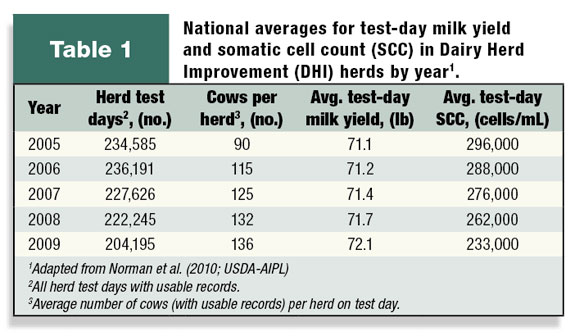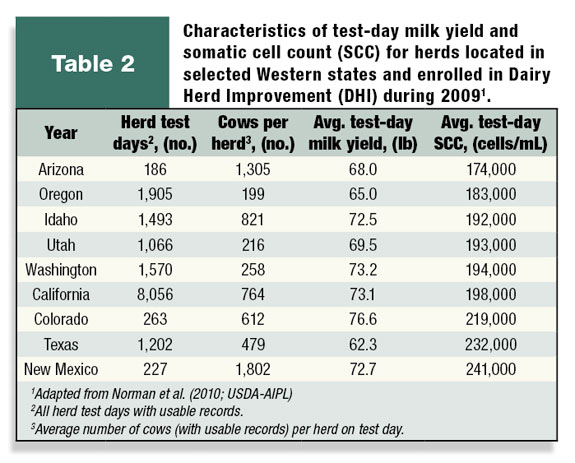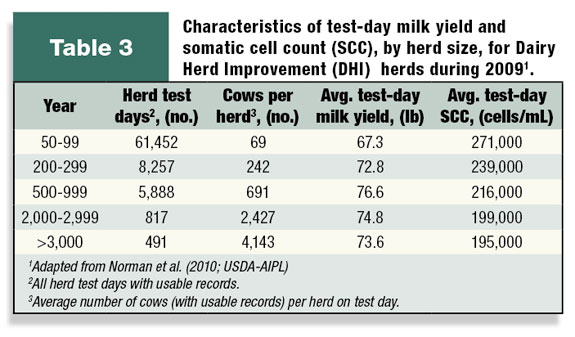Mastitis is the most costly disease of dairy cattle. Estimated losses due to mastitis approach $200 per cow per year in the United States. Sources of loss include reduced milk production, discarded milk, premature replacement costs, extra labor, drugs and veterinary service. This translates into an estimated annual loss of nearly $400,000 for a herd with 2,000 lactating cows.
The somatic cell count (SCC) is the most commonly used measurement for assessing the health of the mammary glands. White blood cells compose the overwhelming majority (99 percent) of the cells included in the somatic cell count, while the remaining 1 percent of cells in milk from an infected quarter will be milk secretory cells. Somatic cells have two primary purposes in the udder – to fight infectious microorganisms and help repair milk secretory tissues damaged by infection or injury.
Test-day data from herds enrolled in Dairy Herd Improvement (DHI) somatic cell testing during 2009 were examined to assess the status of milk quality by the Animal Improvement Programs Laboratory (AIPL) in Beltsville, Maryland. According to AIPL, all test-day data within a herd were included regardless of breed. Data from owner-sampler herds were also included.

Table 1 shows the total number of herd test days, the average number of cows (with usable records) per herd on test day, and the average test-day milk yield and SCC. The 2009 national average test-day SCC (233,000 cells/mL) was considerably lower than the average for 2008 (262,000 cells/mL), and continues a trend of declining average test-day SCC in the past five years ( Table 1 ).
The current legal limit for bulk tank SCC is 750,000 cells/mL for Grade A producers; however, lower limits have been proposed on a number of occasions by the National Mastitis Council. In fact, California has already lowered their state standard for legal milk to 600,000 cells/mL.
Nationally, the range in average test-day SCC was 174,000 cells/mL (Arizona and Wyoming) to 440,000 cells/mL (Alabama). Characteristics for test-day SCC for DHI herds located in selected Western states are shown in Table 2 .

The decline in national average test-day SCC over the past five years (Table 1) and the fact that DHI herds located in six out of nine Western states had an average test-day SCC of less than 200,000 cells/mL (Table 2) provides evidence of a concerted effort among dairy producers, employees, veterinarians, university extension personnel and allied industry to develop and implement management strategies to control mastitis and increase milk quality. Nevertheless, there is more work to be done, as herds with an average SCC between 200,000 and 400,000 cells/mL are estimated to be losing 8 percent in potential milk production.

A question I have often heard focuses on whether herd size plays a role in milk quality as measured by average SCC. The answer appears to be “yes” – as herd size increases, milk yield increases and SCC declines ( Table 3 ).
Why would larger herds tend to have lower average SCC than smaller herds? According to Philpot and Nickerson, the relative milk production level plays a role, where larger herds tend to produce more milk than smaller herds, therefore, somatic cells are more “concentrated” in milk from lower-producing herds, and larger herds may have greater management intensity and success in the application of procedures for preventing and controlling mastitis.
In an effort to reduce SCC and optimize milk quality, the focus should be on successful implementation and maintenance of the varied components of a mastitis control program, regardless of herd size. According to the National Mastitis Council, a mastitis control program should include:
- consistent use of recommended milking procedures (strip, dip, dry and attach, followed with a post-dip after removal of the milking unit)
- use of well-functioning milking equipment
- infusion of all quarters with an approved intramammary dry treatment at dry-off
- accurate record keeping
- the treatment of clinical cases of mastitis promptly and appropriately
- culling cows with chronic mastitis
- maintenance of clean facilities to promote good udder hygiene between milkings
- use of pre- and post-dips known to be safe and effective
The data shown in this article provides evidence that many dairies are producing milk of high quality, which is good for the dairy producer, milk processor and consumer. Consult with your herd health veterinarian, milk processor, university extension personnel or allied industry (milking equipment and teat dip representative) to implement and maintain an effective mastitis control program, thereby reducing your herd’s average SCC, and increasing the quality of milk produced. PD
PHOTO : Larger herds may have greater management intensity and success in the application of procedures for preventing and controlling mastitis. Photo by PD staff.

-
Joseph C. Dalton
- Extension Dairy
- University of Idaho
- Email Joseph C. Dalton







